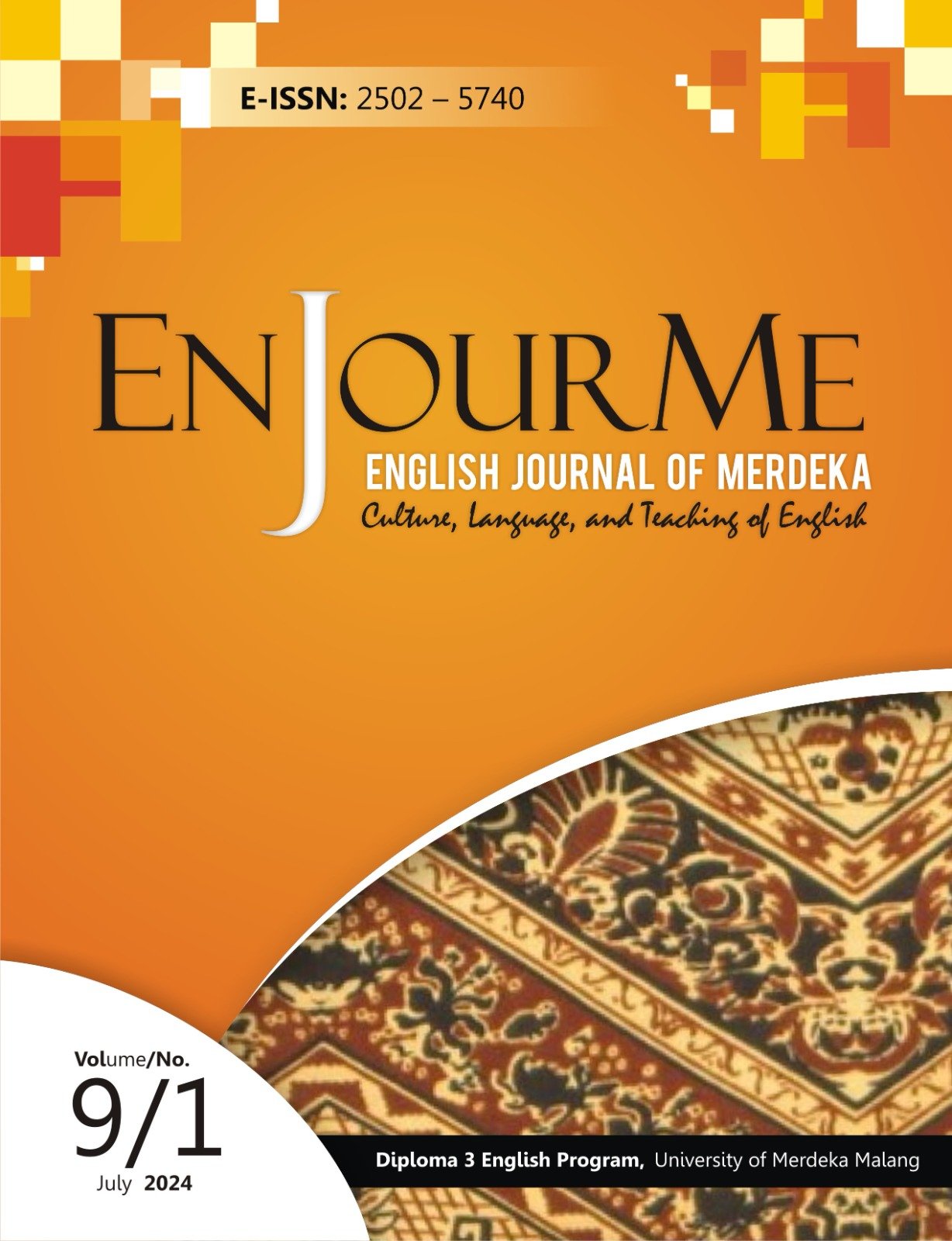A cognitive stylistic of Taylor Swift’s song 'I can do it with a broken heart'
DOI:
https://doi.org/10.26905/enjourme.v9i1.13118Keywords:
Emotional Expression, Interpersonal, Framing, Metaphor, Societal ImplementationAbstract
This study analyzes the lyrics of Taylor Swift's song 'I Can Do It With A Broken Heart' to explore how she conveys themes of resilience and emotional turmoil. The research addresses the gap in understanding the specific mechanisms through which contemporary music reflects complex emotional states. Utilizing qualitative text analysis, the study examines the song's interpersonal dynamics, framing, and metaphors. Findings reveal a tension between the protagonist's public persona and private pain, highlighted through vivid metaphors and imagery that depict resilience despite adversity. This analysis contributes to the broader discourse on music as a form of emotional expression, emphasizing its societal implications.
Downloads
References
Braun, V., & Clarke, V. (2006). Using thematic analysis in psychology. Qualitative Research in Psychology, 3(2), 77-101. https://doi.org/10.1191/1478088706qp063oa
Creswell, J. W., & Poth, C. N. (2017). Qualitative inquiry and research design: Choosing among five approaches (4th ed.). Sage Publications.
Denzin, N. K., & Lincoln, Y. S. (Eds.). (2011). The Sage handbook of qualitative research (4th ed.). Sage Publications.
Gibbs, G. R. (2007). Analyzing qualitative data. Sage Publications.
Guest, G., MacQueen, K. M., & Namey, E. E. (2012). Applied thematic analysis. Sage Publications.
Nowell, L. S., Norris, J. M., White, D. E., & Moules, N. J. (2017). Thematic analysis: Striving to meet the trustworthiness criteria. International Journal of Qualitative Methods, 16(1), 1609406917733847.
https://doi.org/10.1177/1609406917733847
Ryan, G. W., & Bernard, H. R. (2003). Techniques to identify themes. Field Methods, 15(1), 85-109. https://doi.org/10.1177/1525822X02239569
Saldaña, J. (2015). The coding manual for qualitative
researchers (3rd ed.). Sage Publications.
Smith, J. A. (2000). Interpretative phenomenological analysis. In G. M. Breakwell, S. Hammond, & C. Fife-Schaw (Eds.), Research methods in psychology (pp. 51-80). Sage
Publications.
Adams, T., & Fuller, D. (2006). The Words Have Changed but the Ideology Remains the Same: Misogynistic Lyrics in Rap Music. Journal of Black Studies, 36(6), 938-957.
Bonanno, G. A. (2004). Loss, trauma, and human resilience: Have we underestimated the human capacity to thrive after extremely aversive events? American Psychologist, 59(1), 20-28.
Horton, D., & Wohl, R. R. (1956). Mass communication and para-social interaction: Observations on intimacy at a
distance. Psychiatry, 19(3), 215-229.
Juslin, P. N., & Västfjäll, D. (2008). Emotional responses to music: The need to consider underlying mechanisms. Behavioral and Brain Sciences, 31(5), 559-575.
Schäfer, T., Sedlmeier, P., Städtler, C., & Huron, D. (2013). The psychological functions of music listening. Frontiers in Psychology, 4, 511.
Wicaksono, I. (2016). Music and Identity: An Analysis of Indonesian Songs. Indonesian Journal of Cultural Studies, 9(1), 45-58.
Wijayanti, R. (2019). The Expression of Heartbreak in Indonesian Pop Music. Journal of Musicology, 7(2), 113-129.
Additional Files
Published
How to Cite
Issue
Section
License
Authors who publish with this journal agree to the following terms:
(1) Copyright of the published articles will be transferred to the journal as the publisher of the manuscripts. Therefore, the author confirms that the copyright has been managed by the journal.
(2) Publisher of EnJourMe (English Journal of Merdeka) : Culture, Language, and Teaching of English is University of Merdeka Malang.
(3) The copyright follows Creative Commons Attribution–ShareAlike License (CC BY SA): This license allows to Share — copy and redistribute the material in any medium or format, Adapt — remix, transform, and build upon the material, for any purpose, even commercially.




